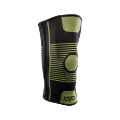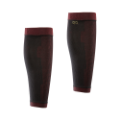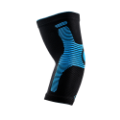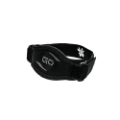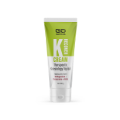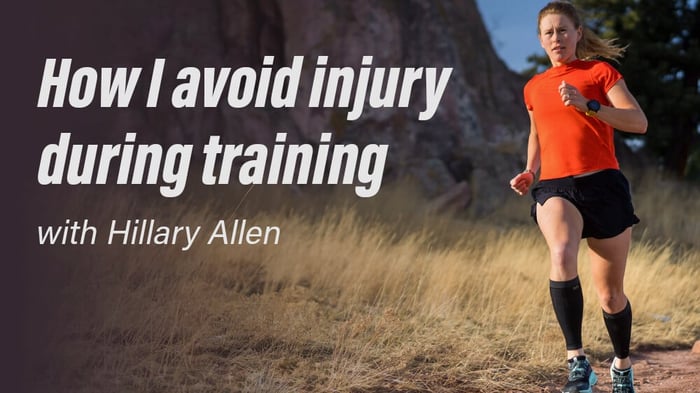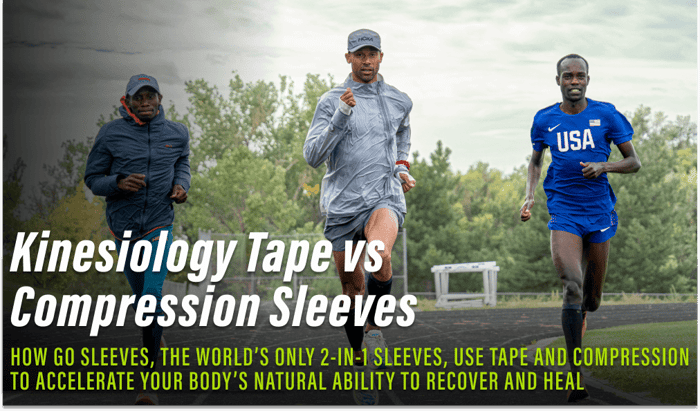How I avoid injury during training and get ready for race day. UltraSignup race tips series 3 of 3.
Ultra race training isn’t just about putting in the miles, it’s about everything else that you’re doing to support your body that’s doing so much for you.
My accident was a pretty uncommon running injury, but it really allowed me to learn a lot about myself as an athlete, not just a runner. Now I incorporate cross-training and strength training is a huge part of my athletic routine to prevent injury. I’ve learned recovery is so important. Not just the way you recover between races, but on a day-to-day basis.
More is not better.
When it comes to training for an ultra marathon, it’s not about doing more. It’s taken me years to be able to work up to the volume that I train at now. My best advice for newcomers – really for any sport – is to realize that training is a process. It’s a long-term process. Learning how to recover correctly is the kind of thing that can dictate your success or failure. Focusing on just the training and putting in the miles without doing the recovery – the supporting work – is like building a house without the proper support structure underneath it. Eventually, something’s gonna break, it’s gonna cave in. I’m talking about strength work – physical therapy if you’re injury-prone – even if you don’t like doing these things, they are preventative and they help you. This also includes good sleep and just taking care of yourself, all those little things add up and really go a long way.
Fast recovery is superpower.
For ultra endurance training – at least for the way I train and coach – your superpower isn’t really how fast you can do the races, it’s how fast you can recover. Yes – sometimes it is your ability to withstand training day in and day out, especially for those who are running ultra distances for the first time. But for those who are trying to find consistency in training for the long-term to go for better outcomes, recovery is everything. It’s almost like your body is a sponge. If you can quickly wring it out better and better with more efficiency, the better your training becomes over time.
Do more with less, but do it consistently.
Trying to cram in all the miles while training for an ultra marathon in a way that isn’t sustainable – like only on weekends – is a good way to lead to injury. The most experienced runners will often say that. It’s more important to create consistency. It’s better to do some good back-to-back runs instead of just one singular long run. But that’s just my style and the way I coach. I’ve found really good success in training that way.
It’s important to have rest and recovery days every week. It’s something your body needs and you’ll start to look forward to them. This includes active recovery days where you’re stretching and moving, but not putting in long miles.
Staying motivated only takes 10 minutes.
When I’m tired and feeling unmotivated, what I do is give myself 10 minutes. I get out the door and say, “Okay. You’re going to run for 10 minutes.” And if I still feel crappy, I give myself permission to do something else. More often than not – like 90% of the time – I keep going. The same rule applies to workouts. I just make myself do the first interval and see how it feels. Usually, I end up doing all 10 of them. It’s about taking things one step at a time and giving yourself permission to respond to the way you’re feeling - you’re not going to feel great every single day and there’s no reason to force yourself into injury. Be smart and know when to push it and when to pull yourself back.
So, it's race day. You're Trained, Relaxed, Recovered. Now what?
First and foremost, I never do anything in a race that’s brand new. If I haven’t practiced it in training, I won’t do it on race day – especially when it comes to gear. My drop bag is carefully planned and out on the course, ready in case my race strategy changes.
Have a winning calf strategy.
I have chronically tight calves. I used to deal with that by wearing compression socks, but now whether I’m training or racing, I relieve tight muscles by using GO Sleeves® Calf Sleeves to reduce soreness and keep my lower legs and Achilles from tightening up. They kind of combine kinesiology tape and compression into one thing. I don’t have to tape up AND wear a sleeve to get better blood flow and support with reduced pain, and swelling management all at the same time. After I started wearing them, I noticed an incredible difference, so they are always in my drop bags. One less variable to worry about is always a good thing. Can you imagine the distraction of kinesiology tape getting scraped by a branch and peeling off your knee 15 miles into a 50-mile race? I also always use my calf sleeves for recovery days and recovery runs to speed recovery.
Take care of your knees, they connect lots of muscles.
I’m always focused on keeping my quads stretched and in good shape. There are a lot of connection points between your quad muscles and hamstrings to the front and back of your knee. So, GO Sleeves Knee Sleeves have definitely been a lifesaver, sometimes I don’t use them until later in a race, but that’s a strategy I’ve practiced for.
Overpack, just a little.
Other gear that I have ready for race day are layers – we are in the mountains after all. I keep a full change of clothes and kit in my drop bags. An extra jacket, blister treatments, socks, a new shirt, extra nutrition. My strategy might change halfway through the race and it could become more about just completing the distance. I might be relegated to a walk. So, I definitely have poles in my drop bag.
Train to make nutrition predictable, but be ready for change.
It’s funny how I think about nutrition for long races. I always have something salty later in the race. I try to practice nutrition in my training runs, but sometimes they aren’t long enough for me to figure everything out. I have to pack my drop bags with extras like chocolate candy and cola. Nutrition is where I have to leave myself room for a little surprise or change in tactics during the race.
I always have a bag of nutrition that includes the absolute essentials to get from point A to the next one, but I’m not afraid to pack extra. If I need to take a minute, I’ll set a timer to get me up and keep me going so I don’t waste all my time messing around with my drop bag stop.
Follow GO Sleeves for more running tips.
Sign-up for emails or follow @GOSleeves to stay updated with the latest running tips from coaches, pros and athletic trainers.
Skyrace endurance runner Hillary “Hillygoat” Allen was ranked #1 in the world in 2017 when she seemed to defy death itself after experiencing a life-threatening 150-foot fall from a ridge-line while competing. After 14 broken bones and 11 months of recovery, Allen healed up, defied the odds, and placed 2nd in her next race.
Since then, Allen has made a complete recovery, currently running her most challenging events ever, but not without the help of intense rehab and technology from GO Sleeves. GO Sleeves for Calves have helped her counter muscle tightness and soreness while improving blood flow and lymphatic drainage to her calf muscles, Achilles tendon, and shin splints.
Learn more about Hillary’s running tips and sign-up for her newsletter at hillaryallen.com.
